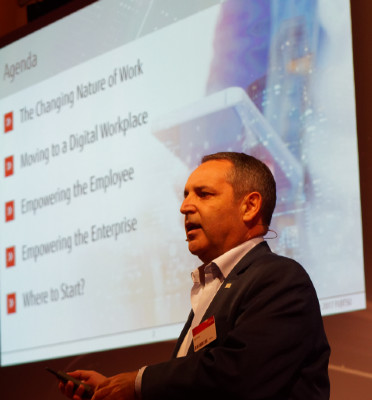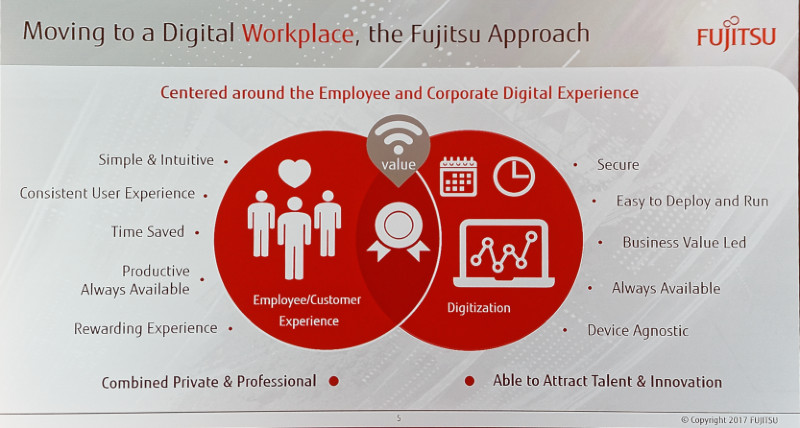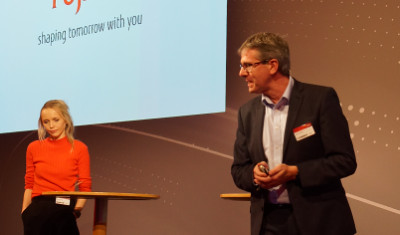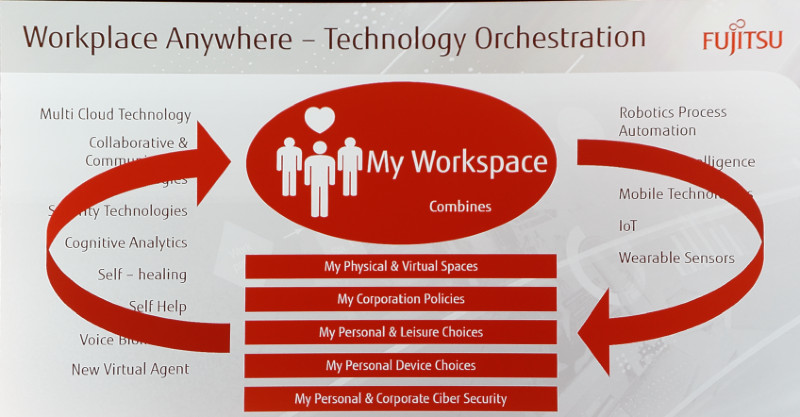 Fujitsu’s Jose Pinto Head of EMEIA Workplace Anywhere Offering Management started off a session called “The digital workplace – a glimpse of the future!”
Fujitsu’s Jose Pinto Head of EMEIA Workplace Anywhere Offering Management started off a session called “The digital workplace – a glimpse of the future!”
Where to start might be the question, Pinto said, but the process of moving to digital workplaces has already started, so a better question might be “how to continue?”.
The nature of work and leisure is changing and has always been itself dependent on the nature of technology. What is different today is that there is a very rapid development in technology and there is much more rapid innovation than in the past. Cycle times for development get quicker and that is a challenge. At one time, change was slow – taking years or even decades, but now things are changing very fast.
In the past, people’s tasks were very repetitive with productivity measured by the number or speed of repetitions, but, increasingly, tasks now have to be creative and there is less repetitive work. It is expected that workers will develop new concepts and creative ideas. Increasingly, there is a merging of leisure and work – each becomes part of the other. That means that workers are creating their own lifestyles that are a blend of work and leisure. For different generations of workforce, you need to be able to deal with different lifestyles, but all connected to an IT system.
 Fujitsu’s approach to the digital workplace
Fujitsu’s approach to the digital workplace
There is a move away from being attached to a device, to being able work anywhere. There is a digital transformation with applications like Facebook, Skype, Whatsapp in peoples’ private lives, but corporations have different needs with CRMs, ERPs and other applications that need to be used. There are a lot of legacy tools and a big question is how to make them integrated with the more modern tools?
At a human level, everything is emotional. Emojis are emotions in a digital place. Productivity is no longer about the speed of execution of a task, but about other factors. Systems need to be simple and intuitive and available at the time when the user wants to work. However a lot of apps are complex and that is why they need a lot of support.
There are different requirements from the corporate side – for example security which is essential and needs to be device agnostic, easy to run and install and always available. Further, the corporation needs to appeal to the best people, so the applications need to be attractive to the user.
 Smithen brought on a ‘Millenial’ to talk about the approach for younger workforcesMartin Smithen of Fujitsu’s Digital Workplace Management group then showed a video that he had created about ‘the first day in a job’. It was an idealistic idea of how a new member of staff would be integrated into a corporate IT stucture in the future (and, we expect, a long way from today’s reality!).
Smithen brought on a ‘Millenial’ to talk about the approach for younger workforcesMartin Smithen of Fujitsu’s Digital Workplace Management group then showed a video that he had created about ‘the first day in a job’. It was an idealistic idea of how a new member of staff would be integrated into a corporate IT stucture in the future (and, we expect, a long way from today’s reality!).
In 2025, over 50% of people will not regularly go to an office to work and it’s hard to deliver the vision seen in the video (of seamlessness and integration) today. Increasingly, technology needs to ‘bring joy’ to the work day. Technology at home is often contextual and easy to use and the IT in the workplace needs to become the same. Especially younger users want to be able to access everything on the move. Uber and other services have been successful partly because they get a lot of user feedback and users feel they are helping to create the services. They won’t read a manual or get instructions – apps just need to be easy and obvious.
Attention spans are shorter for younger workers and that can be a challenge, Smithen said. He also said that Fujitsu needs to be more responsive to make the most of the opportunities that digitisation is presenting.
Pinto then came back and said that before you can build such systems, first you have to understand the corporation and its culture. Fujitsu has a wide range of tools and apps available that can be brought to bear in a wide range of areas of hardware and software.
The company has built Cloud-based models – based on ‘t-shirt sizing’ (small, medium and large for different organisations) with software working, for example, on local or public clouds depending on the scale and policies of the user. The company is also building application suites with more flexibility in terms of contract times etc,
IT managers need to look at devices beyond PCs and tablets and should even look at automotive and IoT interfaces and wearables as these will also have applications in the future.
Pinto then went into a sales pitch for Fujitsu explaining its services and scope.
 Fujitsu’s Workplace Anywhere approach needs to understand corporate culture. Image:Meko
Fujitsu’s Workplace Anywhere approach needs to understand corporate culture. Image:Meko
Analyst Comment
The kinds of concepts of work and lifestyle consideration that were discussed in this talk seemed a long way from the kind of considerations that are often discussed in the kind of big corporate projects that Fujitsu takes on in public and private industry. There are big hurdles to be overcome to make SAP and other corporate software secure and to get them to ‘bring joy’ and creativity to worker’s lives! (BR)

